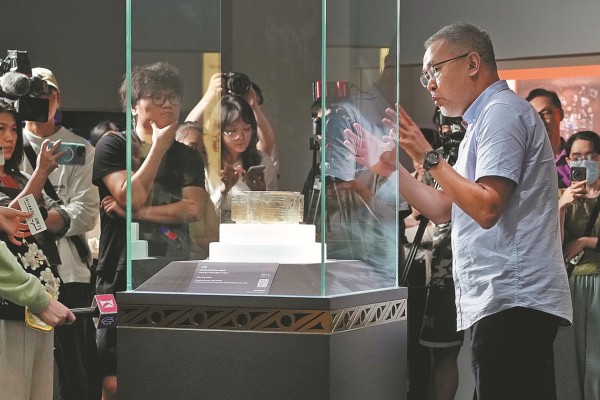
Fang Xiangming, head of the Zhejiang Institute of Archaeology, introduces a jade cong belonging to Liangzhu culture, from about 5,300 to 4,300 years ago, at Shanghai Museum. [Photo by Gao Erqiang/China Daily]
Proof of Early China: The Civilization of Songze and Liangzhu opened on Tuesday in Shanghai, the second show of The Essence of China exhibition series presented by Shanghai Museum.
The exhibition displays cultural relics and archaeological achievements tracing the origins of Chinese civilization.
Organized by Shanghai Museum with support from the administration of cultural heritage of Shanghai, Zhejiang, Jiangsu and Anhui provinces, the exhibition is the first and largest exhibition in China featuring the archaeology of prehistoric civilizations of the lower Yangtze River region.
On display are 358 pieces and sets of objects from 19 museums and archaeological institutions around China, 90 percent of which are recognized as precious cultural relics, and one-third of which are newly excavated objects making their first public appearance.
The first show of the series, Making of China: The Civilizations of Xia, Shang and Zhou Dynasties, took place last year at Shanghai Museum and 200,000 people visited in three months, said Chu Xiaobo, director of Shanghai Museum.
"This time, we will focus on the lower Yangtze River region approximately 5,800 to 4,300 years ago," Chu said at the opening ceremony on Monday.
"With the Songze and Liangzhu cultures as its core, this region played a crucial role in the formation and early development of Chinese civilization."
The lower Yangtze River region is one of the important birthplaces of Chinese civilization, said Chen Jie, deputy director of Shanghai Museum and a veteran archaeologist.
About 5,800 years ago, megacentral settlements emerged for the first time within some settlement clusters in the lower Yangtze River region, such as Songze of suburban Shanghai's Qingpu district and Lingjiatan of Hanshan county in Anhui province.
From the population of inhabitants to large building structures and high-profile tombs excavated and discovered at these sites, archaeologists found that social hierarchy and authority came into being, and the privileged classes had conspicuous control over abundant wealth and resources.
The settlement clusters continued to integrate and expand as they competed against one another, leading society to the era of the ancient states.
Approximately 5,300 years ago, Liangzhu culture emerged as the pre-eminent civilization encompassing a vast expanse of the lower Yangtze River region. Its capital was established in ancient Liangzhu, situated in today's Yuhang district of Hangzhou, Zhejiang province.
At the exhibition are some of the most treasured objects borrowed from other museums and institutions.
Fang Xiangming, head of the Institute of Archaeology in Zhejiang province, introduced a signature object of the Liangzhu culture, a jade cong (tube) unearthed from the Fanshan site in 1986.
With its height reaching 8.9 centimeters and a weight of 6.5 kilograms, it is the largest and most elaborately sculpted jade cong of Liangzhu culture that has been unearthed.
The relic can only be shown in Shanghai till July 10, when it will be returned to Zhejiang Museum.
"We went to all the museums and cultural relic institutions in the Yangtze River Delta, to select the best and most representative objects for this exhibition, which is the fruit of collaboration among the museum community of Zhejiang, Jiangsu and Anhui provinces, and Shanghai," Chu said.
The exhibition, running until Oct 8, is expected to be as popular as the first in the series.
To ensure the safety of cultural relics and a good visiting experience, visitors must make an appointment on Shanghai Museum's WeChat mini-program before they come.